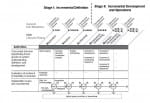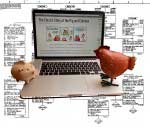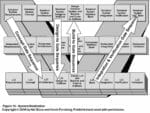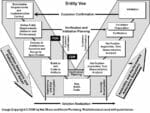The Incremental Commitment Model (ICM) was presented in 2006 in a paper titled Using the Incremental Commitment Model to Integrate System Acquisition, Systems Engineering, and Software Engineering written by Barry Boehm (Spiral Model) and Jo Ann Lane, a Principal at the University of Southern California Center for Systems and Software Engineering. The ICM model emerged primarily […]
Legend of the Chicken and Pig
The Scrum framework consists of Scrum Teams and their associated roles; Time-Boxes, Artifacts, and Rules. Every Scrum team has a ScrumMaster responsible for making sure Scrum practices are followed and impediments to progress removed. The ScrumMaster does not manage the team. Teams are self-organizing with no more than 7 members. There is a Product Owner […]
The Dual Vee
Recognizing insufficiencies with all Waterfall based models including their own Vee-Model, Forsberg and Mooz continued to refine their thesis. They presented a Dual Vee-Model in a 2006 paper titled “The Dual Vee – Illuminating the Management of Complexity.” In the abstract they said: The Waterfall, Spiral, and Vee models are reminder models that guide us […]
US Vee Model
The US Vee-Model was first discussed at a joint conference sponsored by the National Council on Systems Engineering (NCOSE) and American Society for Engineering Management (ASEM) in Chattanooga, TN on October 21–23, 1991. A paper named “The Relationship of System Engineering to the Project Cycle” written by Dr. Kevin Forsberg and Harold Mooz, Co-Principals for […]
A Funny Thing Happened on the Way to the V-Model
In the late 1980s two countries, Germany and the United States, simultaneously but independently developed a V-Model. While the two models are similar in concept, they differ enough to be considered alternative approaches. The German V-Modell was developed in part by IABG in Ottobrunn, near Munich in cooperation with the Federal Office for Defence Technology […]







Recent Comments